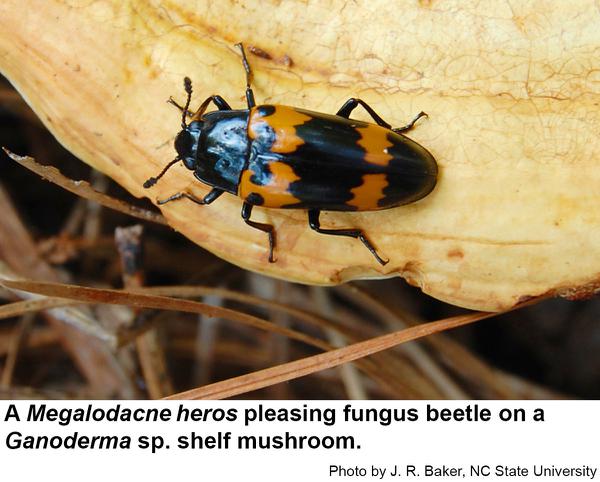Description and Biology
Pleasing fungus beetles in the genus Megalodacne are, indeed, pleasingly shiny black with irregular, contrasting, yellowish-orange bands across the forewings. The body is an elongate oval in top view and ½ to 7/8 inch long. Although these beetles are not rare, they are seldom noticed perhaps because the adults are nocturnal. They sometimes congregate under bark or rotting wood usually within 25 feet of Ganoderma infested trees and stumps. They emerge at dusk to feed throughout the night. Females lay their eggs on the fruiting bodies of shelf fungi in the genus Ganoderma and other wood rotting fungi. Megalodacne larvae hatch and feed in the woody fruiting structures (sporophores) of bracket fungi. Development passes quickly: two weeks from egg to pupa is not uncommon with some pleasing fungus beetles.
Host Plants
Megalodacne pleasing fungus beetles breed in the harder Ganoderma bracket fungi found on dead trees and stumps. Ganoderma fungi rot the roots of hemlock, honeylocust, maple, mimosa, redbud, sweetgum, and water oak. Adults have been reported feeding on Fomes applanatus and a species of Pezizia as well as Polyporus species and other fungi.
Residential Recommendations
Since the pleasing fungus beetles are secondarily breeding in fungi on diseased and dead trees, it seems control measures should be directed at keeping trees healthy.
References
- A Revision of the Erotylidae of America North of Mexico (Coleoptera). Boyle, W. W. 1956. Bull. American Museum of Natural History 110 (2): 61-72.
- Common name: pleasing fungus beetles, scientific name: Pseudischyrus, Tritoma, Megalodacne, Ischyrus spp. (Insecta: Coleoptera: Erotylidae). Skelley, P. E. 1999 (revised 2014). Featured Creatures. Entomology & Nematology, FDACS/DPI, EDIS.
- Extension Plant Pathology Publications and Factsheets
- Horticultural Science Publications
For assistance with a specific problem, contact your local Cooperative Extension Center.
This Factsheet has not been peer reviewed.
Publication date: Sept. 17, 2016
Revised: Oct. 3, 2019
N.C. Cooperative Extension prohibits discrimination and harassment regardless of age, color, disability, family and marital status, gender identity, national origin, political beliefs, race, religion, sex (including pregnancy), sexual orientation and veteran status.

